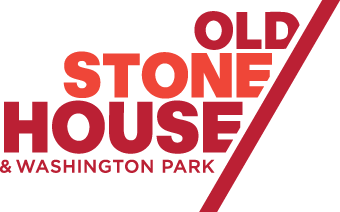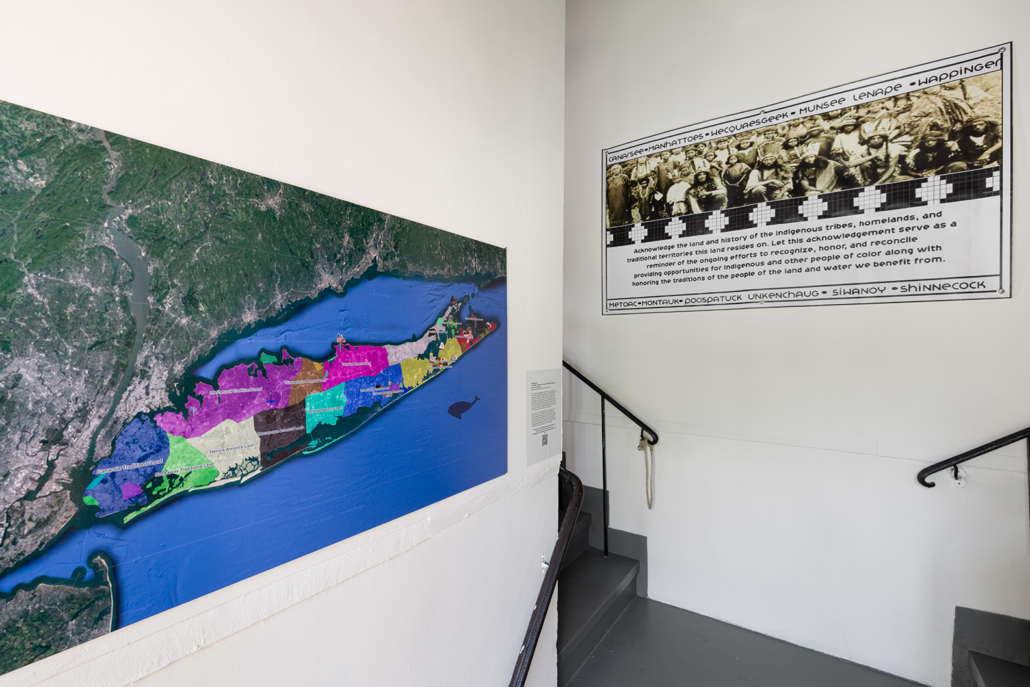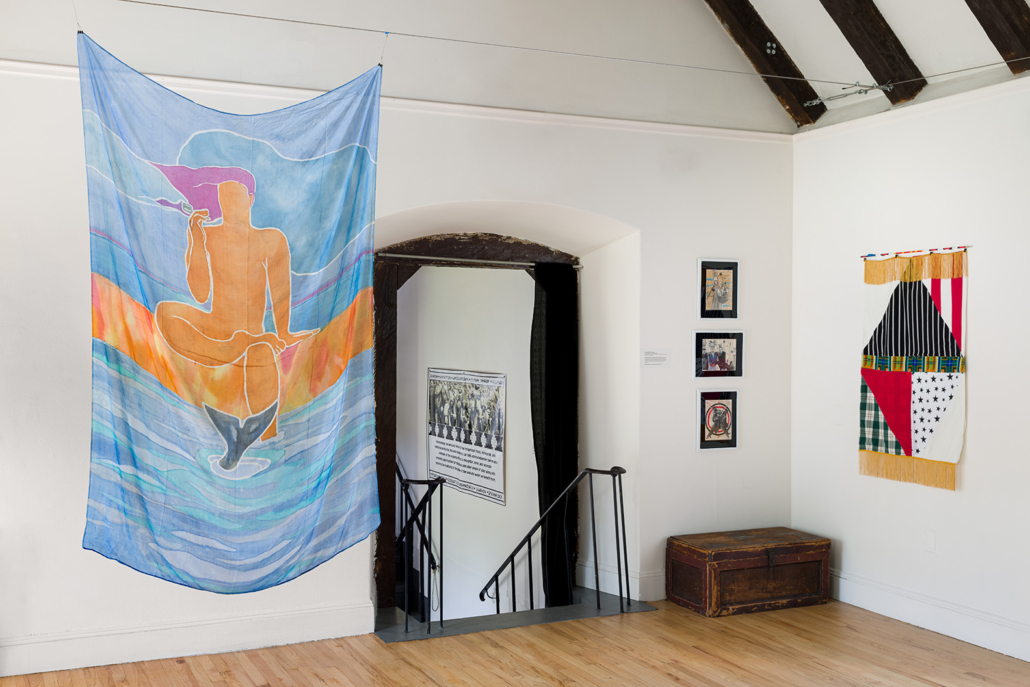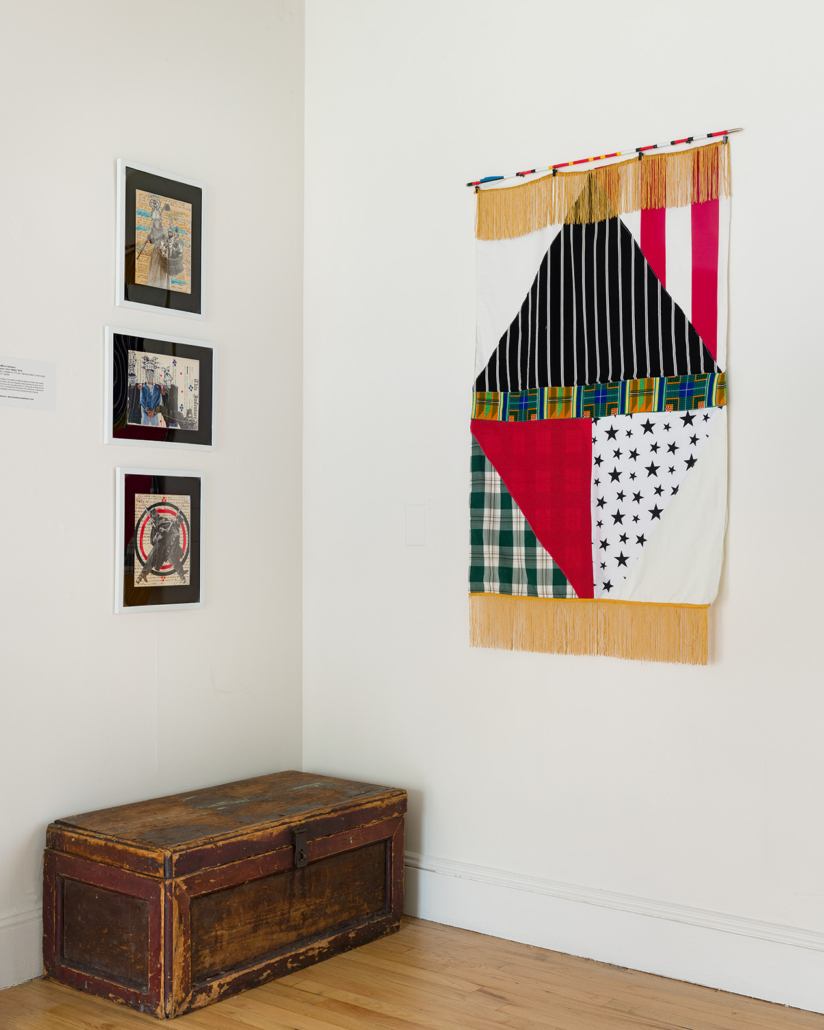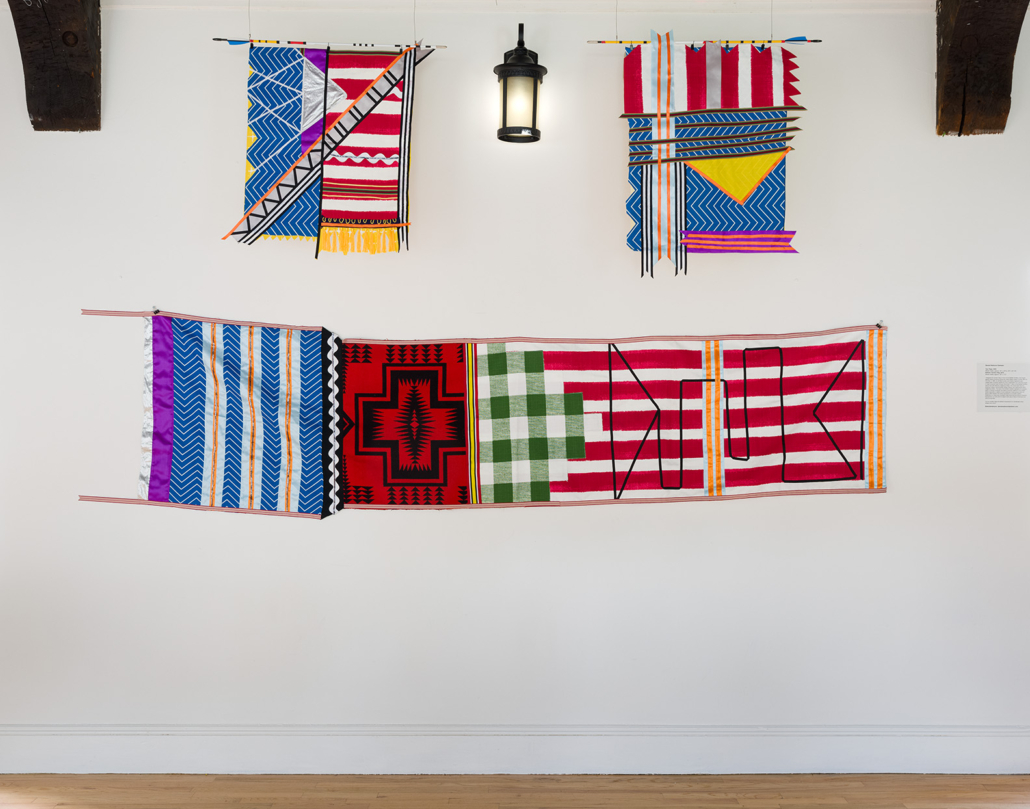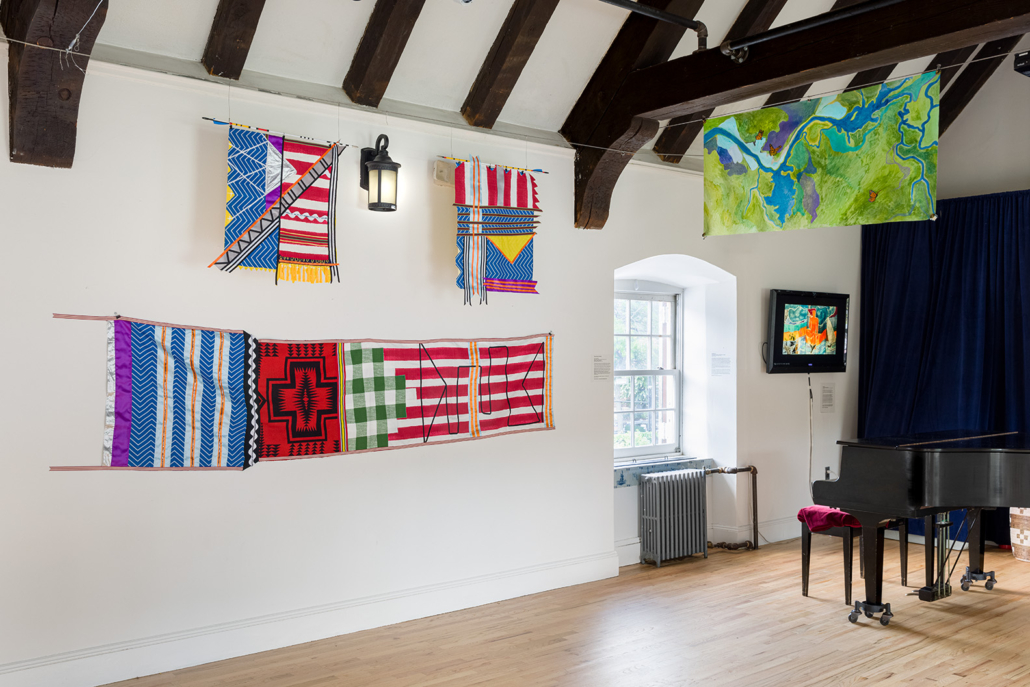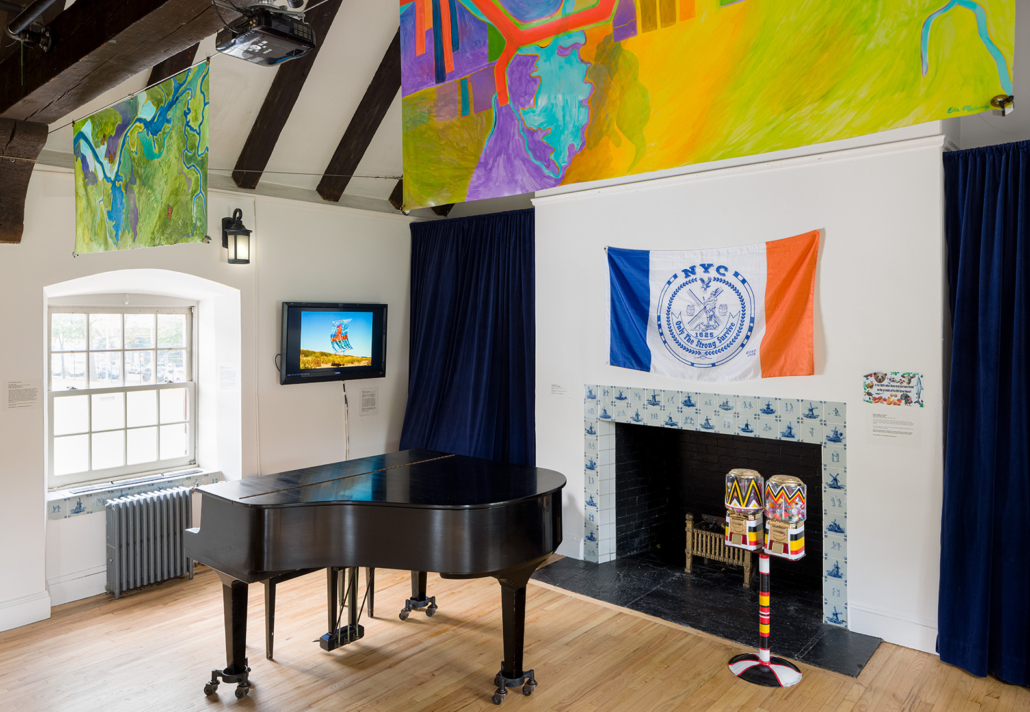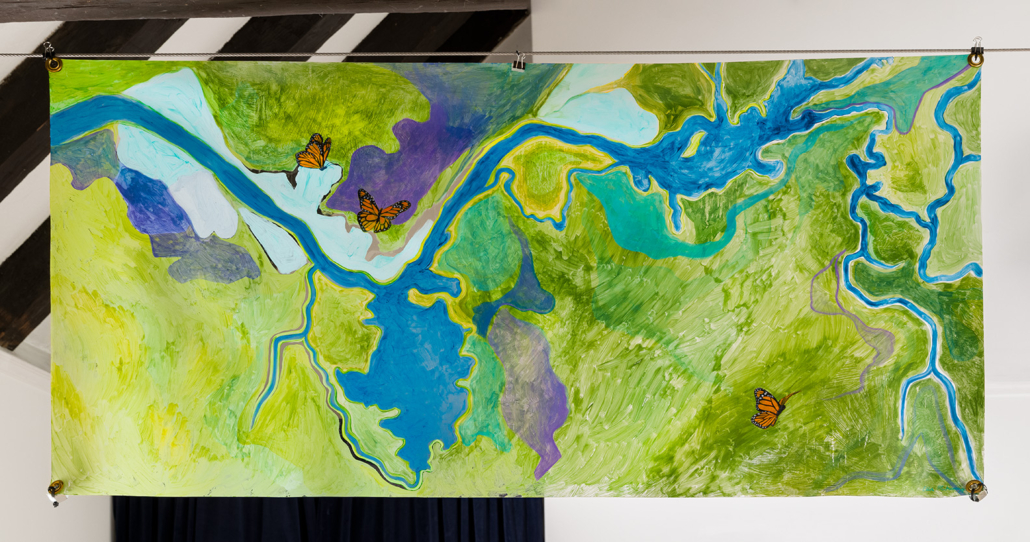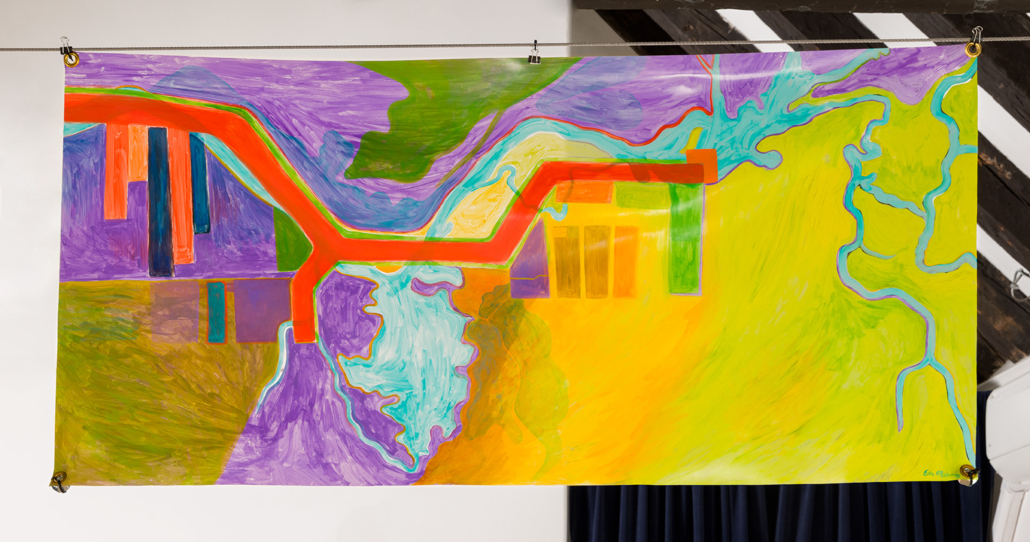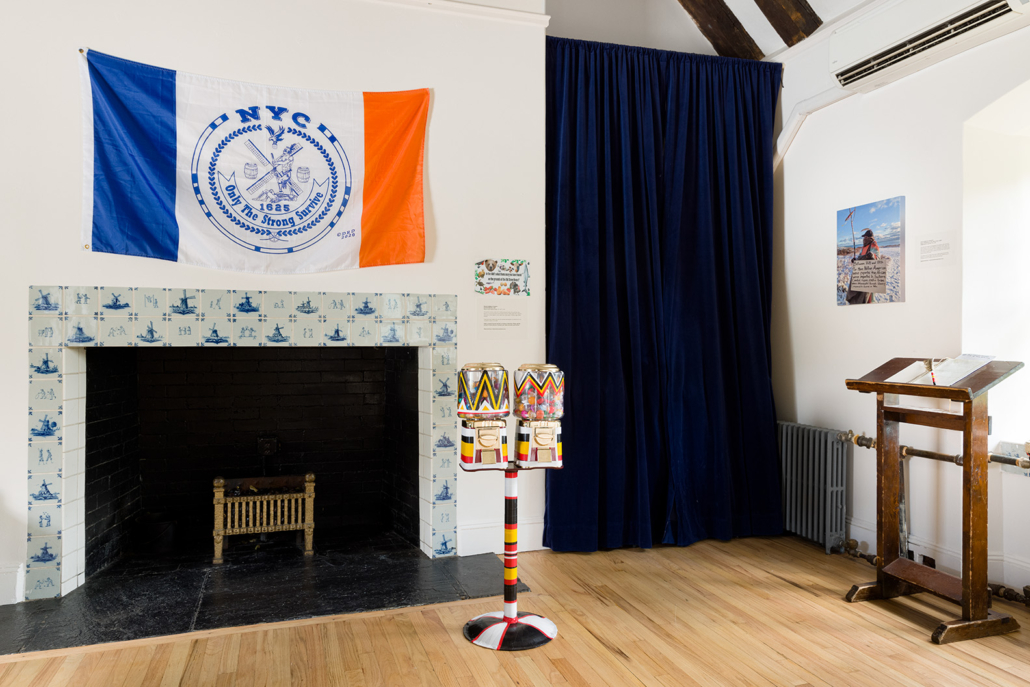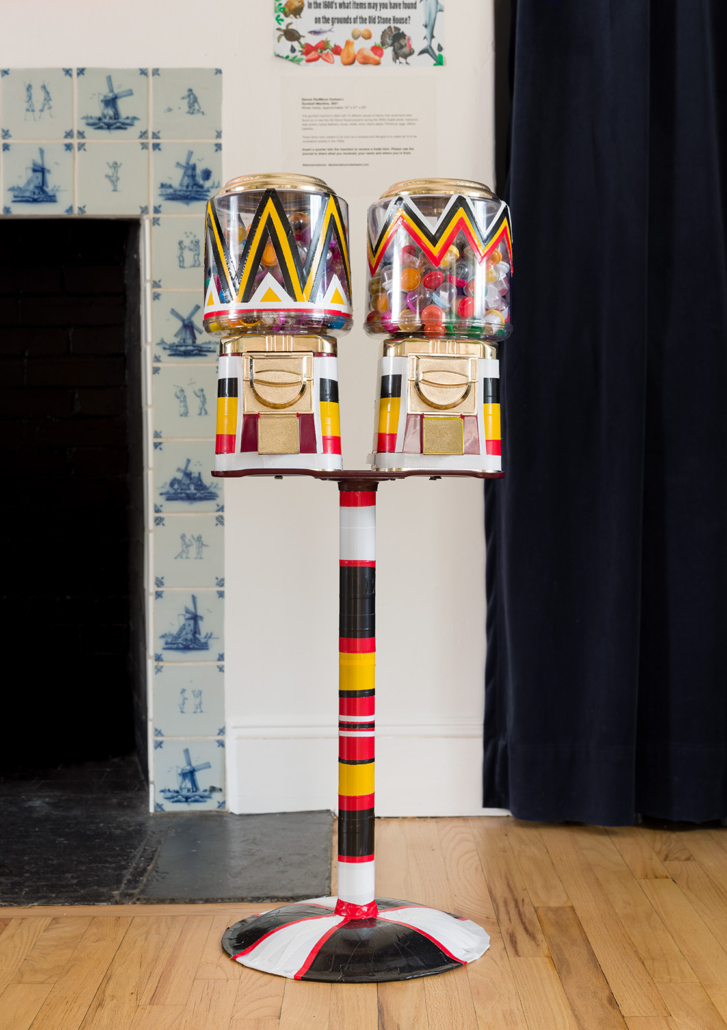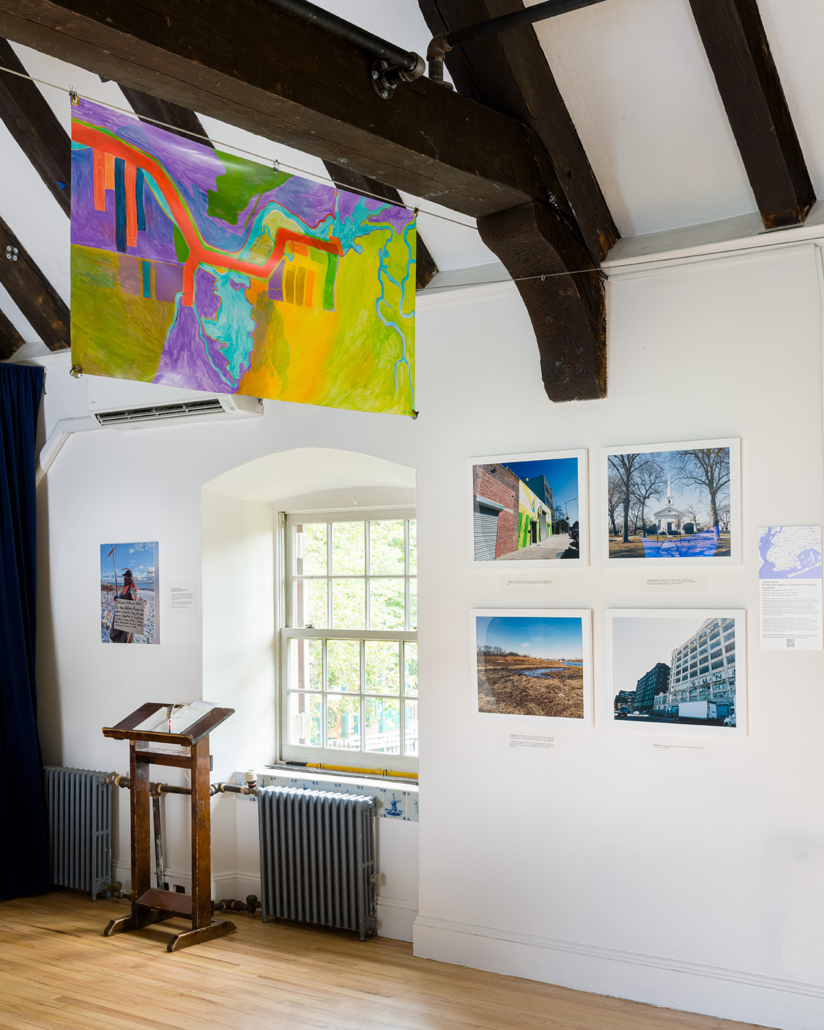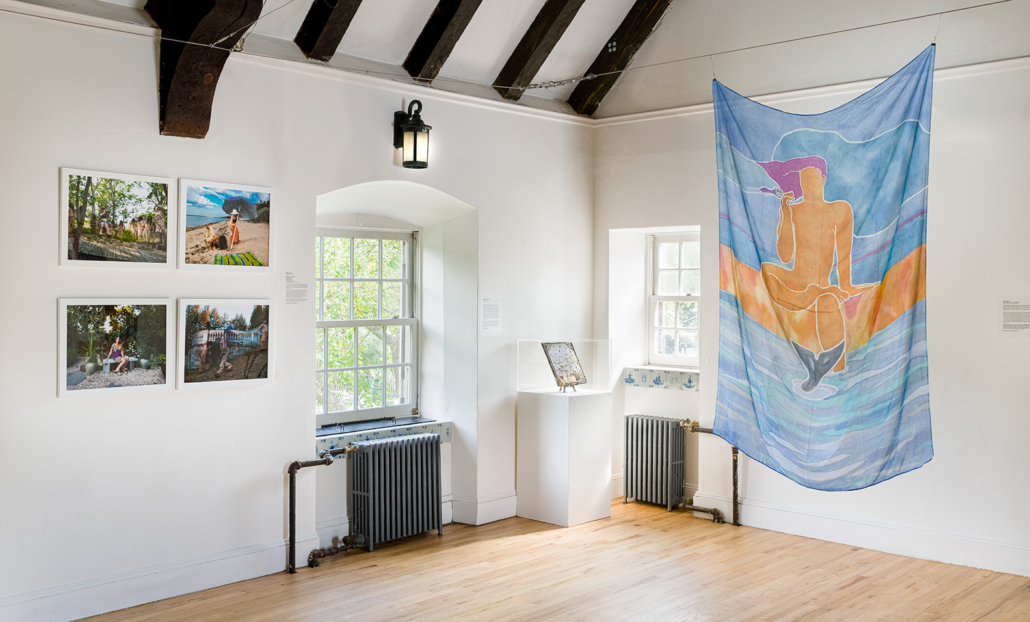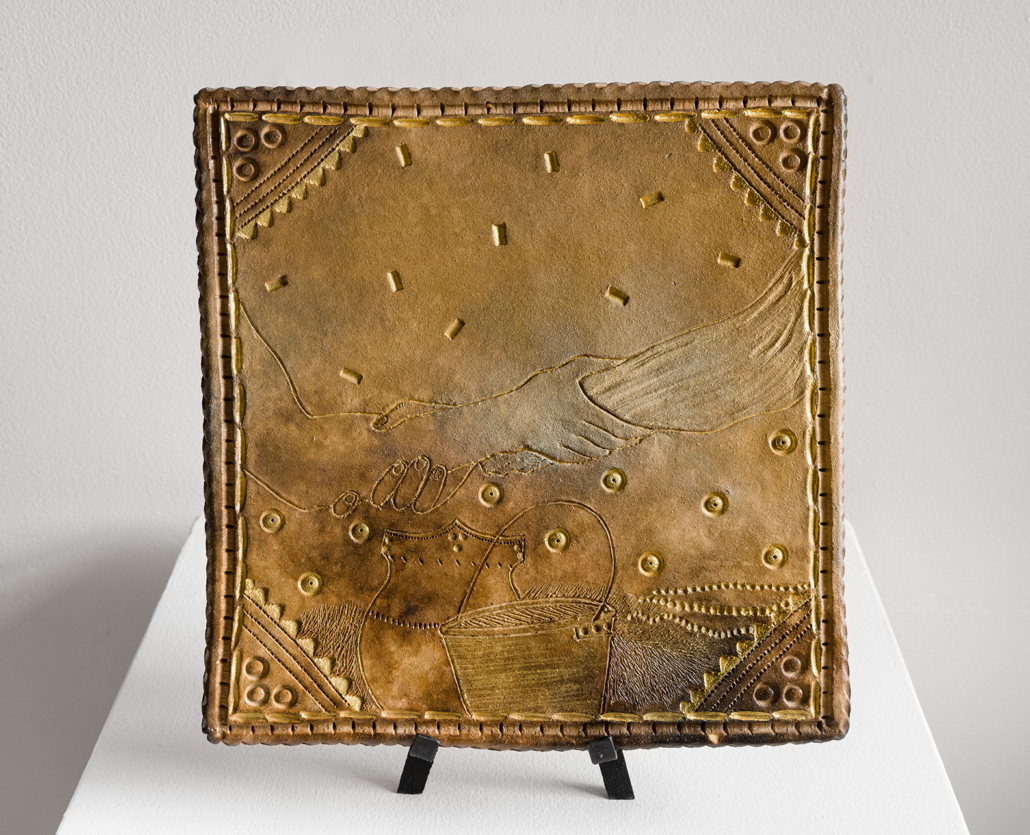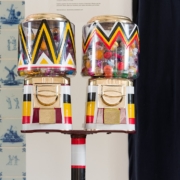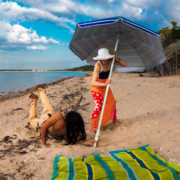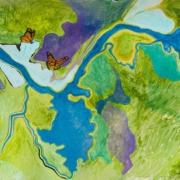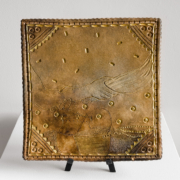This Exhibit is past. Visit our Exhibitions page for information on the current programming.
Land Markings
Artwork by Dennis RedMoon Darkeem, Jeremy Dennis, Ella Mahoney, & Natasha Smoke Santiago
August 22, 2021 – October 11, 2021
Opening Reception September 12, 2021, 4 pm – 6 pm (originally August 22, delayed due to weather).
Gallery hours Friday-Sunday, Noon – 3 pm beginning August 27.
This site-specific exhibition by artists of Indigenous heritage comments on the past, present, and future of land use in the areas surrounding the Old Stone House.
Watch the recording of our Closing Conversation, held on October 12, 2021.
Enjoy this virtual tour slide show of the exhibition, photographed by Etienne Frossard.
Watch the recording of our Closing Conversation, held on October 12.
Public Program September 19, 3 pm – 5 pm: artist Dennis RedMoon Darkeem will lead a workshop on remembering the past to honor the future. This will include meditation and stress-reducing techniques as well as art-making inspired by Indigenous sounds, storytelling, smells and tea drinking. Register here.
More details and a full schedule of public programming in conjunction with this exhibition will be announced soon.
Overview:
Land Markings brings together four New York-based artists of Indigenous heritage who have created site-specific work commenting on the past, present and future of land use in the areas surrounding the Old Stone House. Their work explores such topics as the acknowledgement and preservation of local Indigenous cultural sites in Brooklyn and New York State; under-recognized histories of local trade and land transfer (including the seizure of colonized land); and land use issues facing contemporary Indigenous and other BIPOC communities.
A central theme in all the work is the importance of recognizing the continued presence and influence of Indigenous communities in the New York area. Yet the work also suggests the limitations of mere acknowledgment, in some cases proposing or supporting models of Indigenous sovereignty and sustainability that defy a singular narrative or type of mark-making. Many of the works on view combine traditional craft with contemporary art practices, while rejecting cultural assimilation and asserting the importance of craft, performance and storytelling in maintaining ties to land and community and as a form of activism.
Land Markings precedes the upcoming redesign of the Old Stone House’s permanent exhibit to include its Lenape history. OSH is at the crossroads of ancient Lenape paths, adjacent to the historic town of Marechkawick. In the 1640s, the Dutch West India Company began a series of violent confrontations known as Kieft’s War, breaking its agreements with the Lenape. By 1645, the Lenape of Marechkawick agreed to sell their lands in what would become Brooklyn, forcing them west to Staten Island and the Hudson Valley. Today, despite the displacement of its original Lenape residents, New York City still has one of the largest intertribal Indigenous communities in the country.
Land Markings is the first in a series of exhibits and programs at OSH that will provide opportunities for contemporary Indigneous artists to connect a greater awareness of the past to critical conversations about Brooklyn’s future, including fair and sustainable uses of our natural and built environment.
About the Artworks:
Shinnecock Nation enrolled tribal member and artist Jeremy Dennis presents new photographs of culturally-significant Native American sites in Brooklyn, part of his ongoing On This Site – Indigenous Long Island project to raise awareness of the history and continued existence of native populations on Long Island. His Rise photo series references pop-culture zombie films to convey the ongoing subtle fear of an Indigenous uprising in the United States: “Fear, in this instance, may come from acknowledging our presence, not as an extinct people, but as sovereign nations who have witnessed and endured the process of colonization for hundreds of years and remain oppressed.”
For Haudenosaunee/Mohawk artist Natasha Smoke Santiago, the act of creating traditional Iroquois pottery is integral to “living sovereign” by “living one’s culture…daily, without permission.” For this exhibition she has created an original ceramic tile documenting the history of trade between the Haudenosaunee, Lenape and Europeans in New York State.
Several bodies of work by Yamasee Creek -Seminole and African American artist Dennis RedMoon Darkeem reflect on his experience of living as a mixed-race person in New York City, including “dispelling myths about Native Americans and what we look like.” His work transforms everyday objects that reflect on the historical understanding of the past and explore new ideas of future, questioning post-colonial ideas of value, ownership and exchange. His Land Keepers collages on historic New York land deeds “consider those who are responsible for taking care of land, and…allude to the idea of sovereignty over one’s body without the fear of being displaced.” Large flags, one with a land acknowledgment statement and one that proclaims, “NYC: Only the Strong Survive” address themes of “existence, survival and and taking ownership of historic narratives.”
Ella Mahoney draws from her Aquinnah Wampanoag background to imagine a decolonized future for the Gowanus neighborhood of Brooklyn. A series of new painted outdoor banners created for OSH explore “what the space could be if we healed our relationship to the land and water.” Looking at the potential of the planned Gowanus rezoning to consider affordability and access to marginalized populations, she asks, “How can we make space in the city ecosystem to care for all beings?”
About the Artists & Curators:
Dennis RedMoon Darkeem is inspired to create artwork based on the familiar objects that he views through his daily travels. He discovers elements in existing architecture and among everyday items found within the home. Ultimately, he sets out to express a meaningful story about events in his life and those found with the communities with whom he works. Since his work as a professional artist commenced in the early 2000s, it has evolved into critiquing social and political issues affecting US and Indigenous Native American culture. Much of his art has focused on issues like institutionalized racism and classism, jarring stereotypes, and displacement of people of color. As a multimedia artist, Darkeem expresses these motifs through fine art, performance, and photography. He received a BA and MFA from Pratt Institute. He has exhibited locally and nationally and received awards and fellowships from the Bronx Council of the Arts, Bronx Museum, and the Laundromat Project, among others.
Jeremy Dennis is a contemporary fine art photographer and a tribal member of the Shinnecock Indian Nation in Southampton, NY. His work explores Indigenous identity, culture, and assimilation. Dennis was one of 10 recipients of a 2016 Dreamstarter Grant from the national non-profit organization Running Strong for American Indian Youth. Residencies include Yaddo, Byrdcliffe Artist Colony, North Mountain Residency, Shanghai, WV, MDOC Storytellers’ Institute, Saratoga Springs, NY, and the Vermont Studio Center hosted by the Harpo Foundation. He has been part of several group and solo exhibitions, including the Parrish Art Museum; The Department of Art Gallery, Stony Brook University; the Wallace Gallery, SUNY College at Old Westbury, NY; the Flecker Gallery at Suffolk County Community College, Selden, NY; and the Suffolk County Historical Society, Riverhead, NY. Dennis holds an MFA from Pennsylvania State University, State College, PA, and a BA in Studio Art from Stony Brook University, NY. He currently lives and works in Southampton, New York on the Shinnecock Indian Reservation.
Katherine Gressel, the Old Stone House & Washington Park’s Contemporary Art Curator, is a New York‐based curator, artist, and writer focused on site‐specific art. She earned her BA in art from Yale and MA in arts administration from Columbia. Katherine’s previous exhibits dealing with such topics as income inequality, urban agriculture, and parks have been recognized by the New York Times, Time Out New York, Hyperallergic, News 12 Brooklyn, and DNAInfo. In addition to organizing eleven major exhibitions to date at the Old Stone House, Katherine has curated for FIGMENT, No Longer Empty, St. Francis College, and Brooklyn Historical Society, and was the 2016 NARS Foundation emerging curator. She was selected for the 2015 Independent Curators International (ICI) Curatorial Intensive in New Orleans. Katherine has written and presented on public and community art issues for Createquity, Americans for the Arts, and Public Art Dialogue, among others. Katherine also served as Programs Manager at Smack Mellon Gallery from 2010-2014, and has worked and consulted for diverse nonprofits.
Ella Mahoney is a member of Wampanoag Tribe of Gay Head (Aquinnah) based in Brooklyn, NY; an artist, illustrator, and teacher. She received her BFA in Illustration from the School of Visual Arts in New York City and has since illustrated children’s books, exhibited work in many galleries, and created installations in collaboration with performers. Primarily working in oil, acrylic, and most recently silk paint; her work is based in storytelling and draws inspiration from creation stories; as well as from narratives of her personal experience of indigeneity through lenses of love and nature. Her recent projects explore large-scale silk painting and installation as a medium that invites people to play and participate in creating comfortable, loving spaces connecting them to each other and the surrounding environments.
Natasha Smoke Santiago was born in Rochester, New York and brought up in Haudenosaunee tradition. Her grandparents were part of a Mohawk diaspora in the mid 20th century who moved to cities like Syracuse, Rochester, Buffalo and NYC following the steel trade. She works in many mediums, chronicling traditional Haudenosaunee culture, contemporary life, the miracle of pregnancy and the beauty of the natural world. Natasha is one of a handful of artists, historians and living history enthusiasts attempting to resurrect and further elevate the Iroquoian style of pottery. The Tradition of the Longhouse and living one’s culture, by one’s cultural values, daily, without permission, is a central theme in her being. In the words of an Onondaga Leader: “To be sovereign, one must live sovereign.” In this tradition Natasha attempts to live sustainably on a small piece of disputed farmland, in a land claim area adjacent to Akwesasne. In addition to art, she also practices Indigenous seed keeping, gardening and occasional farming.
Land Markings is made possible by the New York State Council on the Arts with the support of Governor Andrew M. Cuomo and the New York State Legislature, The Shelley & Donald Rubin Foundation, and the New York City Department of Cultural Affairs.
